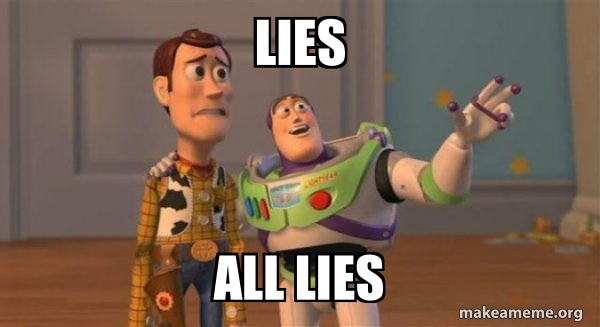
Let’s go through some of the most believable marketing myths and set them straight.
If you’re starting out in your marketing career, you’re probably consuming information like there’s no tomorrow.
Some of that information is absolute garbage. 🗑️
Let’s go through some of the most believable myths and set them straight.

“Email is dead!”
“Webinar funnels are dead!”
You’re going to hear this a lot, as marketing “gurus” decide to be edgy and get a rise from the rest of the community.
Please ignore them. Marketing strategies and channels should be judged on their own merits and by the data.
A channel which doesn’t work for one business might be perfect for another business.
Strategies come and go, but ultimately, it depends on your audience, your goal, your budget and the channels you have to hand. If they don’t work, it’s not because that strategy is useless, it’s because it isn’t appropriate for your business.
Strong garbage vibes from this one.
My opinion: You don’t need to be on any social platform. 😲

Organic social media marketing requires a couple of things to work:
If one of those isn’t present, you might as well throw in the towel.
Importantly, for this myth, the reality is that you should only be on the social platforms which are applicable for your business.
If you’re selling fluffy toys, get the hell off LinkedIn. Unless it’s working for you! Follow the data.
At some point in your career, somebody who doesn’t know a jot about marketing is going to ask you to increase the amount of traffic on their website.
Traffic alone is pretty much pointless.
Qualified traffic, however, is golden.
Quick explainer: Qualified traffic is the name for users who are actually “in-market”. They are your target audience, and either want your product/service now, or will do at some point in the near future.
If you get a lot of generic traffic, you will find your engagement metrics on Google Analytics tank. You may then find that Google starts ranking you less favourably, as it will decide your website is not satisfying visitors.
So, aim for qualified traffic, and you may well find that more traffic = more conversions. Do this by ensuring your ads are well targeted and the copy speaks directly to your chosen audience.
Try not to run ads on very generic keywords. E.g. choose keywords like “small red short-sleeve t-shirts for boys”, rather than “red t-shirts”.

People don’t magically know that your website has just popped up on the internet.
It’s a flawed assumption that traffic will just appear. It takes a lot of work building up your brand awareness through all the various digital channels. Here’s an article on how to choose your channels, if you’re unsure.
Once you’ve got your brand awareness, it takes even more work to convince people to actually visit your website. Then even more work to make them convert.
Phew, that’s a lot of work. Why did we pick this career again? 🤔
You ever Googled a business and seen a load of terrible reviews? Put you off? I bet it did, and rightly so.
So why is this a myth?
Bad reviews can actually be an asset, if you take the time to respond to them frequently and correctly.
It really takes the wind out of a bad review when the owner comes back to them with a solid burn. 🔥

Applying high heat and cooking for 20 minutes isn’t always the best approach though.
Often a better approach is to acknowledge the review, apologise (if you feel it’s necessary/deserved), and offer some form of restitution. Make sure to take further comms offline, either through DM, email or phone. Your pleasant and reasonable response should be the last public take on the matter.
Suddenly, your bad reviews become an asset. You’re publicly shown to care about your customers and willing to go the extra mile to make things right.

Of course, if you get more bad reviews than good, you’re probably just doing a terrible job. Sort it out 🧐.
Hold on, this sounds a lot like Mistake #3.
It’s all well and good focusing on conversions, but if you don’t have a steady stream of brand aware top funnel traffic, you not going to have anybody to convert.
General rule: 30% of your marketing budget should focus on the bottom of the funnel. The other 70% should be on raising brand awareness.
Check out the funnels section in this guide for more info on this.
The fundamental reasoning for this is sound – you do indeed need to keep putting out blogs posts for SEO ✔️.
Where people tend to fall down in this reasoning is that they put up blogs posts for the sake of SEO only ❌.
If you’re not providing actual value to the reader, they won’t hang about and Google won’t rank your posts highly (vast oversimplification, but that’s the gist).
Write for people first, SEO second.
Hard truth: If you wouldn’t want to read it yourself, you’ll probably find it’s low quality content.
You’re going to get pressure from various people to put out blog posts regularly (see: clients, business owners). Ignore them. Put out posts as regularly as you can write good quality, high value content. No more, no less.
This can also be read as “…our marketing should be as boring as possible”. 🥱
Tone of voice is an important concept in marketing. Every business has a “voice” and it should be relevant for the audience they are speaking to.
A quirky craft beer company will probably be a lot more sassy and funny than a corporate legal firm.
However, it is a myth that the coporate legal firm can’t have a bit of edge in their voice.
Here’s a key lesson to take throughout your career:
People buy from people.
Eurgh, that’s such an important concept to internalise. Quick, read it again.
Unless you’re purchasing something very mundane, like kitchen foil, there’s a good chance some sort of marketing has been employed.
You know what unites people? We’re all human. We all like to have fun, chat with our friends, hang out with our family (if they don’t suck), suffer from everyday problems etc.
If your marketing speaks to people on a human level, you’re more likely to make sales.
So, the takeaway is that even if you work for a stuffy law firm, your stuffy, corporate clients are still humans. Try speaking to them like real people and you’ll be impressed with the results.
Blindly believing stuff you read on the internet can set back your efforts to be a decent marketer. The only thing you should believe is this blog.👍
Just kidding, go and do your own research. What I write is still my opinion, and you should do your due diligence before running off and implementing anything you read online.
You know what you should trust? Your data. Track everything and make your own, informed decisions about what works and what doesn’t. You can’t argue with results.
Ignoring your data is Mistake #2. Don’t be that person.
When I used to run marketing teams, one of my main directives was “Always ask why“.

It’s a good habit to get into and should be applied to everything in marketing.
“Why am I writing this content?”
“Why are we allocating this much budget to this channel?”
“Why do people think email is dead?”
Keep questioning, keep learning and follow the evidence. It’s the only way to stay ahead of the curve and not get bogged down by trends and hot takes.
Good luck soldier. It’s a minefield out there.🫡
If you want to read more like this, plus other useful tips and tricks for new and solo marketers, why not sign up to my Clarity newsletter? I won’t send you any spam, promise.
Founder of Latent Clarity and author of the Clarity newsletter.
I help new and solo marketers be the best they can with practical, actionable, (and sometimes funny) advice.